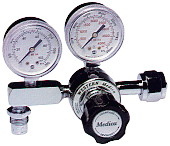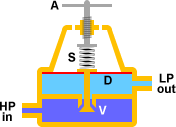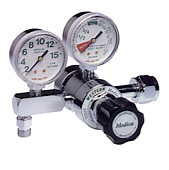|
Regulators
The pressure
contained within gas cylinders is initially very high and falls
as the contents are used. The function of the regulator, or reducing
valve, is to convert this variable, high-pressure gas supply to
a constant, low-pressure gas supply of around 50 psi.

Advantages of
using a regulated, low pressure system in an anesthetic machine
are:
-
It
is easier and safer to manufacture the pipework in the machine
using low-pressure piping and connectors, and the consequences
of a gas leak are less serious.
-
It
eliminates the necessity of constantly adjusting the flowmeters
as the pressure in the cylinder falls.
-
It
enables better control of the gas flow to be maintained: since
the needle-valve and flowmeters are larger for a given flow
rate, they are less prone to inaccuracy due to wear or the presence
of dirt.
Function

As gas flows
out of the low-pressure chamber, the drop in pressure reduces
the force generated by the diaphragm (D) against the spring (S),
allowing the valve (V) to open and admit gas from the high-pressure
chamber. The output pressure may be adjusted by a screw (A) that
alters the force applied by the spring.
Limitations
The regulated low pressure will only remain constant over a certain
range of pressures in the cylinder. If the contents of the cylinder
are used to the point of exhaustion, the pressure in the low-pressure
system will fall. This may present a hazard if, to compensate
for this, the flow control is further opened and, later, a full
cylinder is connected to the system. The high pressure in the
new cylinder will now generate a very high flow into the breathing
circuit which may result in a rapid increase in pressure and barotrauma
to the lungs.
Two-stage
regulators
Two-stage regulators essentially consist of two single-stage
regulators mounted in series, so that the low-pressure chamber of
the first stage becomes the high-pressure chamber for the second
stage. Since the pressure in the intermediate chamber is relatively
constant, this arrangement provides very precise control of the
pressure in the final chamber. Two-stage regulators are relatively
expensive and so are only used in situations where it is important
to maintain the output pressure within close tolerances.
Oxygen
flow regulators
Some oxygen regulators incorporate a Bourdon-type flowmeter and
flow restrictor, and are intended for delivery of oxygen directly
to patients.

They should
not be used to supply oxygen to the anesthetic machine since the
limited flow (typically 8 or 15 l/min) will be inadequate to operate
the quick-flush or ventilator.
Low-pressure
gas supply 
|



